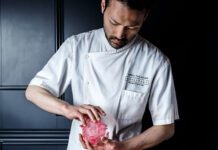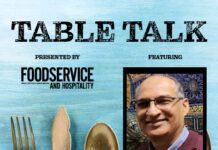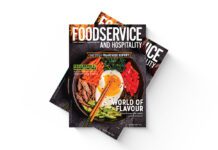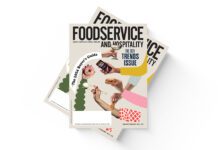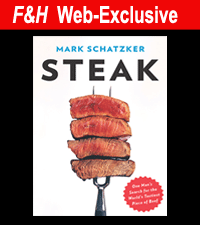Meet the man who circled the globe in search of the perfect piece of beef
Globe and Mail columnist Mark Schatzker has taken on some very cool assignments in his career. As a contributor to Conde Nast Traveler, Schatzker was charged with circumnavigating the world in 80 days and documenting everything, with one caveat; his mode of travel could not surpass 100 miles per hour. He also journeyed back to Europe to experience life as a “Renaissance Man,” visited a swingers convention and has taken countless other trips in search of a good story.
It goes without saying he’s enjoyed some fine meals along the way. Unfortunately for the lifelong beef lover, too few involved great steak. Which got him thinking: why, in this all-things-food-obsessed world, where there are countless tomes written about wine, is there not a similarly authoritative book about steak? Well — after crisscrossing the Atlantic a handful of times, journeying across the Pacific and logging tens of thousands of kilometres by plane, train, car and horseback — there is now.
Schatzker searched America, France, Scotland, Italy, Japan and Argentina for the world’s tastiest piece of beef. He even raised his own cows in Canada. F&H caught up with him to talk about his protein-powered adventure, Steak.
F&H: At the outset of your journey, you obviously held fat and marbling in high regard. But towards the end it seems the best steaks — like the one you had on Alderspring Ranch in Idaho — were from a good breed of cattle raised on grass. Moreover, the quality of the grass they ate was important, as was the soil the grass grew from. And then there’s the weather. It’s a terroir-based argument.
MS: Yes, it is. The key is that the grass is good, but also that the cows get fat on the grass. And that’s what a lot of people get wrong. My biggest fear for this book is that people are going to run out and buy a grass-fed steak and it won’t be good.
Do you think the North American process of grading meat is misguided?
I think it’s a nice idea that you can employ a meat grader to look at sides of beef, and tell if they are good or not — or great, or not. I’m very skeptical whether that’s possible. It made sense in 1926, when the USDA came out with their quality grades for beef, but most cattle were raised on grass back then anyway…The industry has adjusted over the years. Feedlots sprouted in the 1950s, and then there were hormones and antibiotics, growth promotants, basically steroids, and even things called beta agonist. These are all at odds with quality. I believe the quality of our beef has been going incrementally down, for about half a century, to the point that we really don’t know what good beef even tastes like anymore. I’ve spoken to really excellent restaurant chefs, people who are considered luminaries in this country, and I don’t think they have a clue what they are talking about when it comes to steak.
I enjoyed reading about your experience raising Fleurance, your own cow, on Michael Stadtländer’s farm. How did that come about?
I’d realized by that point there were two approaches to raising cattle — grass-fed and grain-fed. But I’d heard of pork being whey-fed, acorn-fed or apple-fed, so why not beef? Now, I wanted to do this in Ontario, but I was worried about the quality of grass. I also needed a supplement, but I didn’t want to use corn. So I thought, “What about apples?” We have lots of apples in Ontario. There’s a nice sugar supplement in apples and I know cows like them. Maybe it will affect the way they taste?
How nervous were you at the Stadtländer dinner, which featured your own beef?
I was incredibly nervous. I was a giant ball of tension. It was just one of my brothers and his wife and Michael, his son and his wife. And it went very well. The tongue was absolutely outstanding. I would put Fleurance’s tongue against anything I tried in Japan.
In Japan, you debunked the myth of the cattle in Kobe drinking beer all day and being massaged with sake, but you did meet a Japanese rancher who was treating his steer like pets. He even shampooed and brushed their hair, and “missed them” when they were gone, which would be viewed as insane on your typical feedlot. You were definitely attached to Fleurance. Was it difficult to slaughter her?
It was a lot less difficult than I thought. I realized afterwards, what I was really afraid of was her being in pain and suffering. And to a certain extent, we anthropomorphize animals — it was the idea that she knew her death was coming and she dreaded it. Because we put ourselves in her shoes and imagine what it would be like walking into a slaughterhouse, which almost has like a holocaust quality to it.
But I realized it doesn’t have to be like this for animals. It was just another day for her — she woke up, I visited her and she drank some beer and ate apples and a bunch of nuts. Then she was loaded onto a trailer and she went somewhere, eventually walking into a room where it faded to black. She wasn’t stressed. She wasn’t fearful, and there was something quite beautiful in that for me.
You believe there’s a correlation between the length of time a steer lives, what it eats and how it’s treated before it’s slaughtered, to how it tastes.
Yes, all these things are factors. It will affect how it tastes in your mouth.
But given the incredible worldwide demand for steak, is this process economically viable?
The feedlots are not going away any time soon. But what’s important, and what we’ve really forgotten is that what makes sense for the beef industry doesn’t necessarily make sense for our mouths. I hope to see the growth of a more artisanal, quality-based meat industry. And that’s not to say it has to be done on a small scale. You can do it on a large scale if you wanted. It’s what they do in Uruguay and it’s what they used to do in Argentina. But I wish everyone, instead of being obsessed with yield, was obsessed with quality. In the same way that good winemakers make good wine. Obviously, they will have to be well-paid for it.
You write, “Great steak isn’st about a good score or technical superiority. It’s about how it makes you feel.” You started out with a goal in mind — would you say that you accomplished it?
I would say the goal changed. People ask me, “What was the best steak you ate,” and it is a bit like asking me to rate my children. I find, as I do with wines, that there are a few I really, really love, but I don’t know if I want to say which one is the best, because they are all a little different. The diversity is what makes it exciting. But the thing that I dislike most about commodity beef is that it all tastes the same.
In your experience, how do Canadian steakhouses rate against ones around the world?
They’re all very similar. Most steakhouses sell commodity beef, because they need to be able to get a lot of it. There are some exceptions, but for the most part, what they’re doing is offering a themed experience — they’re usually Western or some type of gentleman’s club. I don’t think they serve great steak.
If they took your approach, what would happen to their business?
I know some of these restaurants are going to be hostile toward my book, and a lot of people in the steak world and the conventional beef system will think I’m an idiot. I have no illusions about that. But I would still love to see a change. I love the bistecca Florentina you get in Tuscany. I won’t say the best steak I’ve ever had is from Chianina cattle, but for a grain-finished steak, it’s very good. Part of what I love is that it is local. And not to beat the local drum, but when you go for a drive in the hills and you see these white cattle grazing, you think, “this is what I am eating.” There is something exciting about that.
There seems to be a renaissance slowly building for grass-fed beef in Canada, but it’s still nascent. Will it continue to become more popular with meat eaters?
I think it will, but the most important thing small producers have to focus on is quality. I don’t think many of them do. It’s not enough that you’re raising a rare breed on a small farm. It has to taste amazing.
Consistency is among the most important elements in the restaurant business. But it seems the flavour and quality of grass-fed beef fluctuates so wildly, it would be tough for a restaurateur to serve it. What can a chef do?
It’s a very good question. Grass-fed beef can be inconsistent, but it doesn’t have to be. Chefs just need to deal with someone who knows what they’re doing. I’m not saying that nobody in Ontario is doing grass-fed beef well; I’m just saying that nobody I know is doing it well. But I would be really interested for chefs to try the beef from Alderspring Ranch in Idaho. Until you’ve had it, you can’t understand how good it is. Trust me — I travelled around the world looking for it.

Mark Schatzker’s Steak has a publication date of May 8. For more info, click here.
Photo by Fred Lum







